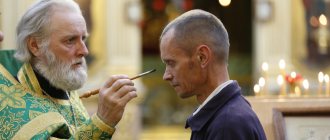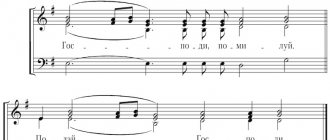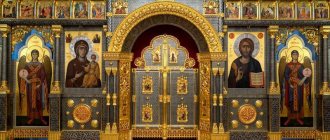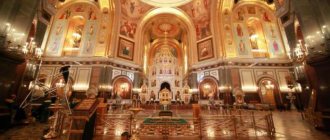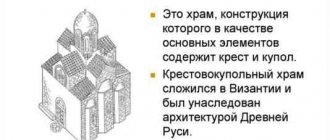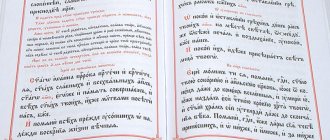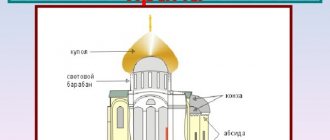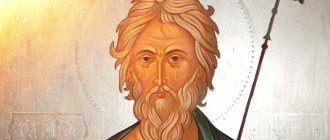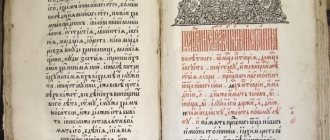The concept of Liturgy and its origin
The first place among church services is occupied by the Liturgy. During the Liturgy, the Most Holy Sacrament of Communion is celebrated, established by our Lord Jesus Christ on Thursday evening, on the eve of the Passion of the Cross.
Having washed the feet of His Disciples to set an example of humility, the Lord took bread, blessed it, broke it and gave it to the Disciples, saying: “Take, eat, this is My Body,” then He took a cup of grape wine and, praising God, gave it to the Disciples, saying: “Drink of it, all of you, for this is My Blood of the New Testament, which was shed for many for the remission of sins.” (Matt. XXVI, 26–28).
Having given communion to the Apostles, the Lord gave them the commandment to always perform this Sacrament: “Do this in remembrance of Me.” (Luke XXII, 19; 1 Cor. XI, 24).
The apostles actually performed Holy Communion according to the commandment and example of Jesus Christ and commanded to perform the Sacrament of Holy Communion in every newly emerging Christian community.
At first, the ritual and order of performing the Liturgy were transmitted orally, then a written presentation of the Liturgy began to appear. The liturgy little by little began to be enriched with new prayers, chants and sacred actions.
The Liturgy has always been celebrated and will be celebrated until the end of time in the Church of Christ, for through Holy Communion we enter into unity with Jesus Christ and are cleansed of our sins. The very word Communion or Communion, that is, communication and participation, means that thanks to this Sacrament we enter into communion, firstly, with Jesus Christ and, secondly, with each other.
The first communion is spoken of in the words of Jesus Christ: “He who eats My Flesh and drinks My Blood abides in Me, and I in him” (John VI, 54–56); about the second - in the words of the Apostle Paul: “There is one bread, one body we are many; for of one body we partake” (1 Cor. X, 16, 17).
The first part of the Liturgy Proskomedia or “Offering”
The first part of the Liturgy, in which the substance for the Sacrament is prepared, is called “offering,” because at the appointed time, ancient Christians brought bread and wine for the Eucharist, which is why the bread itself is called “prosphora,” that is, “offering.”
The substance for the Sacrament is bread and wine. The bread must be leavened (risen), pure, wheat. The bread must be leavened, and not unleavened, because the Lord Jesus Christ Himself took leavened bread to perform the Sacrament. Wheat bread is also taken following the example of Jesus Christ and also because Jesus Christ compared Himself to a grain of wheat (John XII: 24).
In appearance, bread (prosphora) consists of:
- of two parts joined together to designate the two natures of Jesus Christ - Divine and human.
- with the designation of a cross as a sign that this bread is intended for sacred use,
- with the inscription on the sides of the cross Christ the Victorious.
The wine must be grape and red, because Jesus Christ Himself consumed grape wine at the Last Supper. In Proskomedia, when remembering the suffering of the Savior, wine is combined with water, signifying that during the Suffering of the Savior, blood and water flowed from His pierced rib.
For Proskomedia, five loaves or prosphoras are used, but actually for Communion one (the Lamb) is used, as the Apostle says: “One bread, one body we are many: for we all partake of one bread” (1 Cor. X, 17).
General outline of Proskomedia
After vesting (the vesting of the clergy before the Liturgy is done after reading some of the prescribed prayers, in front of the Royal Doors, which is called “performing the entrance”) in all sacred vestments and uttering the initial “exclamation” for the reading of the hours by the psalmist, the priest proceeds to the altar.
Having made three prostrations before the altar with a prayer for the cleansing of sins, the priest takes the first prosphora and with a copy makes the sign of the cross on it three times, saying: “In remembrance of the Lord and God and our Savior Jesus Christ.” This means: we begin to celebrate the Liturgy according to the covenant of Jesus Christ and in remembrance of Him. Then, pronouncing the prophetic words of the prophet Isaiah, the priest makes a cut with a copy on four sides of the middle of the prosphora.
This is how the cubic part of the prosphora stands out and is called the Lamb. The priest places this cubic part (called the Lamb) taken from the prosphora on the paten, cuts the seal crosswise on the opposite side, while pronouncing the words: “One soldier with a copy of His side was pierced and blood and water came out” (John 19:34).
In accordance with these words, wine combined with water is poured into the cup. Having completed the preparation of the Holy Lamb, the priest takes out particles from the following prosphoras.
A particle is taken out of the second prosphora in honor and memory of our Most Blessed Lady Theotokos and Ever-Virgin Mary and placed on the right side of the Holy Lamb.
From the third prosphora, 9 particles are taken out in honor of the nine ranks of the Saints of God and placed on the left side of the Holy Lamb, three particles in a row.
Particles are taken out from the fourth prosphora for the living. The particles taken out about health are placed below the Holy Lamb.
From the fifth prosphora, particles are taken out for the dead and placed below the particles taken out for the living.
After removing the particles, the priest blesses the censer with incense, censes the star and places it on top of the Holy Bread on the paten. Then, having sprinkled incense on the first cover, the priest covers the Holy Bread with the paten with it; Having sprinkled the second cover, the priest covers the Holy Chalice (chalice) with it; finally, having sprinkled a large cover, which is called “air” (the word “air” is the name given to the large cover because, blowing it at the Liturgy during the symbol of faith, the priest vibrates the air), the priest covers the paten and the Holy chalice together with it, saying at each covering the appropriate prayer.
Then the priest censes the Holy Altar and reads a prayer in which he asks the Lord to accept the gifts into “His most heavenly altar,” to remember those who brought the gifts and for whom they were brought, and to preserve the clergy themselves without judgment in the celebration of the Divine Mysteries.
During Proskomedia, the 3rd, 6th, and sometimes 9th hours are read on the choir.
At the third hour, we remember the scourging and outrage of Jesus Christ after the trial by Pilate and, on the other hand, the descent of the Holy Spirit on the Apostles, which happened around 9-10 o’clock in the morning according to our account). Therefore, in the psalms (16, 24, 50) and prayers one hears, on the one hand, an appeal on behalf of the Innocent Sufferer, and on the other hand, a reminder of the Holy Spirit.
At the sixth hour (in our opinion, 12–1 o’clock), the voluntary suffering and crucifixion of Jesus Christ on Calvary are remembered. Therefore, the psalms (53, 54, 90) talk about suffering. In general, the psalms of the 6th hour depict the attempt of the Jews on the life of the Lord and the machinations to kill Him, their ridicule and curses, the earthquake and the darkness that then covered the earth, etc. The last one, Psalm 90: “He lives in the help of the Most High ”, indicates help from the Father to the Son in His sorrow, and in the words: “Treading on the asp and basilisk,” etc. - to His victory over hell.
At the ninth hour (in our opinion, 3–4 o’clock), the Death on the Cross of Jesus Christ is remembered and its significance for our salvation is depicted.
The psalms (83, 84 and 85) point to “salvation accomplished through the death of Christ” to the fact that “He is the living God, died for us in the flesh, and was a sacrifice for us and obtained favor for the earth, which He brought back from captivity - our souls, and revived us with his resurrection, made his people glad, and spoke peace”; finally, it is said that in the suffering of Jesus Christ “mercy and truth met, righteousness and peace kissed each other” (Ps. 84).
Psalm 85 - “Incline, O Lord, Thy ear: prophetically depicts that He who was crucified and died for us is holy, good, meek, abundantly merciful, true, that He gave us strength, strength and did a sign for good.
Psalm 83 speaks of the future faith of the pagans in Jesus Christ, that “people will go from strength to strength, the God of gods will appear in Zion.”
The New Testament events remembered on the clock are spoken of especially clearly in the following troparions, which are read and sung only during Lent.
Troparion of the 1st hour: Tomorrow hear my voice, my King and my God.
Hear my voice in the morning, my King and my God.
Troparion of the 3rd hour: Lord, who sent down Thy Most Holy Spirit in the third hour by Thy Apostle: Take not that Good One from us, but renew us who pray to Thee.
You, Lord, Who at the third hour sent down the Holy Spirit on the Apostles, do not take this Spirit away from us, but renew us who pray to You.
Troparion of the 6th hour: And on the sixth day and hour on the cross the daring sin of Adam was nailed to paradise, and tear up the handwriting of our sins, O Christ God, and save us.
Lord, You, Who on the sixth day and at the sixth hour nailed to the cross Adam’s sin, which he boldly committed in paradise, tear away the record of our sins, O Christ God, and save us.
Troparion of the 9th hour: For at the ninth hour you tasted death for our flesh, put to death our wisdom in the flesh, O Christ our God, and save us.
Lord, Christ God, who tasted death for us in His flesh at the ninth hour of the day, put to death the wisdom of our flesh and save us.
Clock diagram
- Normal start
- Three psalms - at the 1st hour - 5, 89 and 100; at the 3rd hour - 16, 24 and 50; at the 6th hour - 53, 54 and 90; at the 9th hour - 83, 84 and 85 ps.
- Glory and now alleluia
- Troparion of the “hour”, holiday or Saint, (“Daily” troparion from Octoechos, and to the Saint - from the “Menaia”)
- Theotokos
- Trisagion, "Our Father"
- Kontakion of the holiday or Saint (Kontakion of the day - from Octoechos, and the Saint - from Menaion)
- “Lord have mercy” 40 times. “Glory even now”, “The most honorable cherub”
- Prayer: “For every time and every hour”
- Closing prayer to the Lord Jesus
Note: Troparion and kontakion from Oktoechos only on Sunday or Lent.
Ascending to the heavenly throne, like Christ to Heaven, into the bosom of the Father, the priest reads the prayer “Blessed art thou on the Throne of the glory of Thy Kingdom, seated upon the Cherubim...”. This ascent takes place to listen to the Word of God - the Holy Scriptures, which is the pinnacle of the Liturgy of the Catechumens.
The reader at the high place takes the blessing from the priest to read the Apostle and goes to the middle of the temple, as if to the peoples of the whole world, to sow the Word of Christ into the hearts of people.
“Apostle” in church language is an excerpt from any Epistle or Acts of the Apostles. Each day of the church year (except for Great Lent, when the Liturgy is not served on weekdays) has its own special reading, as does each holiday. Thus, two (sometimes three) Apostles can be read at the Liturgy.
"Peace to all!" - exclaims the priest. This is how the Lord, after His glorious Resurrection, greeted His disciples (Luke 24:36). With this greeting He sent them to preach the Gospel throughout the world. “Peace,” according to the words of St. John Chrysostom, “is the mother of all blessings and the foundation of joy.” In the word “peace” the Lord taught His disciples, and through them all the shepherds of Christ’s Church, the power of the spiritual world (John 14:27). To the priest’s greeting “Peace to all!” the reader on behalf of all those praying says: “And to your spirit,” - a response wish for the same peace from the Lord to the clergyman teaching the blessed peace. During the reading of the Apostle, incense is performed. It was established as a sign of reverence before the reading of the Gospel and indicates that through preaching the Gospel grace of the Holy Spirit, spilling out to all ends of the world, sweetened the hearts of people and turned them to Eternal Life. (2 Cor. 2:14).
Before the Apostle, a verse from the Psalter is sung, called the “prokeimne,” which translated from Greek means “preceding.” For each Liturgy, a suitable prokeimenon is prescribed, preparing us to hear the Word of God. The Prokeimenon introduces us to the mystery of the Word. For the Word of God is addressed not to one mind, but to the whole person, to that depth, or, in the language of the holy fathers, the heart, which is the organ of religious knowledge, in contrast to the incomplete, discursive and rational knowledge of “this world.” Hearing and understanding the Word is preceded by the “opening of the mind”: “Then he opened their minds to understand the Scriptures” (Luke 24:45). It can be said that the joyful repeated proclamation of the prokemena, its “communication” to the congregation and its acceptance by the congregation, expresses in worship that moment of “opening of the mind,” connecting it with the heart, when we hear the words of Scripture as the words of the Lord*.
The Prokeimenon is sung in its entirety only twice, the third time the first half is spoken by the reader, and the other half is sung by the choir. If two prokeimnas are supposed to be sung, then the first one is sung twice, and the second one – once. On Sundays the Sunday prokeimenon is sung in the current voice. If the twelfth holiday happens on Sunday, then only the prokeimenon of the holiday is sung.
*) Prot. Alexander Shmeman. Quote Op. — P. 90.
Directions for reading the Apostle
The reader must receive a blessing from the serving priest to put on the surplice and to read the Apostle, after which he goes to the indicated place to read the appointed Apostle.
After the choir sings the Trisagion and the priest exclaims: “Peace to all,” the reader says: “And to your spirit.” Deacon: “Wisdom”, the reader pronounces the prokeimenon. The choir sings the prokeimenon, then the reader recites the verse, and the choir sings the prokeimenon a second time. Next, the reader pronounces the first part of the prokeimna, and the choir sings the second part. At the end of the singing of the prokeemna, the deacon exclaims: “Wisdom,” and the reader pronounces the inscription of the apostolic reading, for example: “Reading the Acts of the Apostle,” “Reading the Catholic Epistle of John,” “Reading the Epistle of the Holy Apostle Paul to the Galatians.” Deacon: “Let us hear,” the reader reads more appropriately the conception of the Apostle.
At the end of reading the Apostle, the priest quietly pronounces “Peace be upon you,” the reader answers him in the same tone: “And to Thy Spirit.” Deacon: "Wisdom." The reader, after saying: “And to Your Spirit,” immediately says: “Alleluia” (three times). The choir sings: “Alleluia” (three times). The reader says the verse, the xop sings a second time: "Alleluia", then the reader says the second verse, and the choir sings a third time: "Alleluia". The reader, having crossed himself, enters the altar through the southern doors, takes a blessing from the serving priest and then unmasks himself.
On some days there are two apostolic readings and two prokemenas. The order of singing the prokeimenon is as follows: the reader pronounces the first prokeimenon, the choir sings this prokeimenon, then the reader pronounces the verse of the prokeimenon, and the choir sings the prokeimenon a second time. Next, the reader, instead of the first half of the prokeimenon, pronounces the second prokeimenon. The choir also sings the second prokeimenon.
Some prokeimnas have inserted words, for example: prokeimnas for the feasts of the Mother of God. "Song of the Mother of God", prokeimenon on the Sunday of Sts. Fathers: “Song of the Fathers.”
The alleluary is always sung only three times. Some alleluaries have one verse instead of two; in this case, it must be divided into two parts or repeated. If two alleluaries are given, the first verse should be taken from one, the second verse from the other. At the Liturgy, more than two apostolic readings are not read, two began. If on any day you have to read three apostolic conceptions, then they are read as two, i.e. one conception is read “under conception” with the other.
Note: The expression “under conception” means that the two Apostles are read as if they constitute one conception, i.e. There is no long pause between the readings of two conceptions.
When reading the two apostolic principles, the following order is observed:
1. First, the conceptions of the day (i.e. Ordinary) are read, then to the saints:
a) on all days of the week, except Saturday;
b) on Saturdays from the Sunday of the Publican and the Pharisee to the Sunday of All Saints, i.e. during the period of singing the Lenten and Colored Triodion.
c) on all Sundays (except for the weeks before the Exaltation and after the Exaltation, the week after the Nativity of Christ),
d) on the days of the dedication of the Theotokos feasts, the ordinary conception is first read, and then to the Mother of God.
2. The apostle is read first to the saint, and then to the ordinary on Saturdays from the Sunday of All Saints until the Sunday of the Publican and the Pharisee.
Note: In the Apostle there are conceptions designated by the word “from the floor,” i.e. from half.
